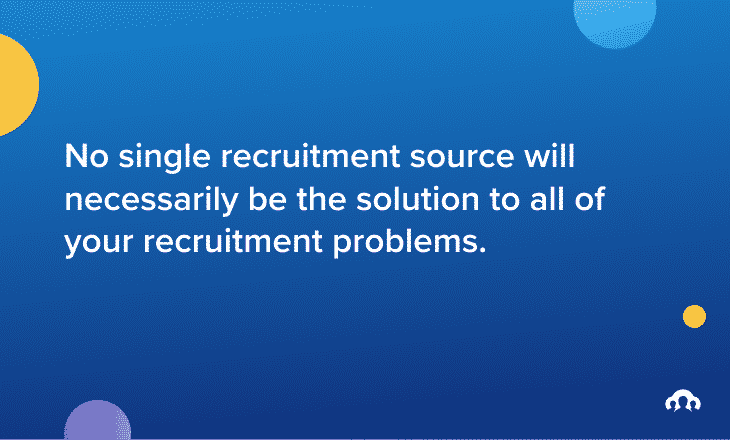Planning your recruitment strategy can be a daunting task in today’s competitive talent environment.Knowing where to look, which sources of recruitment to use, how to structure your job ads, and how to move your candidates through the funnel are all essential skills that you need to land your perfect hire.Fortunately, with a bit of research and even more strategic planning, you can create a recruitment system to find, screen, and hire the right talent for your organization that’s repeatable and profitable for your company.One of the first steps in this strategic planning process is to understand which recruitment sources are available to you and how to harness them as part of your overall recruitment strategy. In this article, I’ll discuss the two main sources of recruitment: internal and external.

Before we get started, you should note that no single recruitment source will necessarily be the solution to all of your recruitment problems. You should be looking at several recruitment sources to broaden your search area and get your job postings in front of as many qualified candidates as possible.
What are internal sources of recruitment?
These recruitment sources involve motivating employees within your organization to apply for vacant job postings in the company.Think of this as a promotion or lateral movement motivator for your employees. Typically, vacant job postings would be communicated to your colleagues via internal job boards, word of mouth, intranets or wikis, or any other communication channels your team uses.
Advantages of internal sources of recruitment
- Motivating skilled employees in your company with the promise of upward growth.
- Reducing employee turnover.
- Reducing recruitment and training costs.
- Guaranteeing that your vacant positions are filled with candidates who fit and understand your company culture.
- Improving overall job satisfaction and morale within your team.
- Encourages self-development of existing employees.
- Promotes training and development.
Showing your candidates that you’re willing to promote and move them into roles that will help further their careers demonstrates your commitment to them and their goals. It also means that you fill your vacancies with qualified and pre-screened candidates.
Disadvantages of internal sources of recruitment
- Less chance of new ideas and alternative solutions being introduced to existing operations and issues.
- Better quality external candidates may be overlooked.
- Promoted employees may not always hold the best qualities for their new role.
- Limiting the acquisition of fresh talent may hamper business growth.
- Less choice from a limited resource pool.
- Encourages favoritism and nepotism.
Another issue to consider with internal recruitment sources, however, is the potential tendency toward confirmation bias. Or, simply put, fewer outside voices introduced into your company to shake things up and move the dial.It’s always a good idea to take a hard look at the requirements for each job vacancy you have and, together with the hiring manager, determine if an internal or external candidate is the ideal solution.
Examples of internal sources of recruitment
Now that we’ve talked about what internal sources are and why you should use them let’s look at a selection of examples. Here’s a list of some of the most common types of internal recruitment sources you can consider for your recruitment strategy.
- Employees can be moved laterally within your organization into similar jobs or vacancies that complement their skill set. With or without a salary change, it’s a great way to re-structure your team while also reducing boredom and stagnation among your employees.
- Vacancies can be filled by promoting your most skilled employees into more senior roles. This is a great way to motivate employees, reduce turnover, and show a commitment to career growth.
- Employee referrals. Encourage your employees to refer family, friends or former co-workers who they think would be perfect for your vacant positions. This helps find qualified and vetted candidates who often have a higher likelihood to fit seamlessly into your team and culture.
Internal sources of recruitment are a fantastic way to harness the best assets you already have at your disposal: your employees. Couple these internal sources with external ones, and you’ve got yourself a robust and well-rounded recruitment strategy.
What are external sources of recruitment?
If internal recruitment sources refer to all potential candidates within your organization, then it makes sense that external recruitment sources all about motivating candidates outside of your company to apply.This is your typical candidate fishing expedition, and there are many ways to lure and catch an ideal applicant. You just need to find and deploy the right combination of external sources of recruitment.
Advantages of external sources of recruitment
- Providing a larger and more diverse pool of candidates.
- Bringing new ideas and skills into the organization.
- Promoting your employer brand and culture.
- Filling your talent pipeline with candidates for future consideration.
- Less chance of favoritism and disrupting healthy workplace atmosphere.
Disadvantages of external sources of recruitment
- Jealousy and frustration of existing employees looking for promotion.
- Lengthy and costly process.
- Finding a suitable applicant isn’t guaranteed.
- Longer periods of adjustment to a new role and organization.
- Possibilities of mismatching and choosing the wrong candidates.
Before deploying external recruitment techniques, however, it’s important that you do your homework into who your candidate is, where they’re searching for jobs, and what they’re looking for.Be sure to tailor any external sources of recruitment to a well-thought-out strategy to ensure that you’re not inundated with hundreds of unqualified candidates.Depending on the strategy, external recruitment can be a time consuming and expensive endeavor, so you want to make sure your investment will yield positive results.
Examples of external sources of recruitment
You’re likely already familiar with many external recruitment sources – these are some of the most common techniques recruiters use to find candidates. To get you thinking, here’s a list of some of the most common external sources in use today.
- Online job boards. Self-explanatory. Think of websites or any other page that lists job posting. These can either be free or paid, targeted or broad. Find out where your ideal candidates typically search for jobs and get your ads posted.
- These are similar to job board postings but are broader and don’t necessarily need to be online. Think of all the websites, newspapers, magazines, and even physical places your candidates likely visit on a daily basis and post some appealing job ads. These are typically paid placements, but the right location can yield great results if targeted properly.
- Applicant Tracking Systems (ATS) or other recruitment software. Take a deep dive into the candidate pools you’ve collected from previous search efforts to see if there are any qualified applicants you can reach out to. Use an ATS like Recruitee to search for specific parameters to narrow down your efforts.
- Educational institutions. Makes connections with universities, colleges, and trade schools and invite new graduates into your company for internship positions. These are great future high performers that you can scoop up early in their careers.
- Trade associations, conferencing, and network events. Where industries hold particular professional or trade associations, accessing a database of members could open a host of new potential hires. Trade magazines and journals are also options as fresh job role advertising opportunities. These areas are ideally placed for locating experienced and skilled candidates.
- Former employees. Don’t be afraid of rebound or boomerang employees. In today’s job market, it’s very common for people to jump from company to company to progress through their career. If you have a vacancy that might appeal to a former colleague, reach out to them to see if they’re ready to make a comeback.
- Previous applicants. A database of previously unsuccessful candidates delivers a resource pool of possible options. If they failed to win the role purely because another candidate held better qualities or credentials, they could still be perfectly suitable to fill the position.
- Rival businesses. Some of the best operatives in your industry will be working for your competitors. They might not be looking to relocate or for a better opportunity, but you won’t know unless you ask. Just because they’re not actively looking for a new challenge doesn’t mean they’re not ready for one.
- Social media. LinkedIn is a no-brainer for recruiters. Search for candidates based on job title, skill set, and location to find high potential candidates and reach out to them via InMail. Don’t be afraid to search Twitter and Facebook for industry-relevant pages and groups that you can reach out to as well.
As mentioned earlier in this article, no one source of recruitment will be the solution to all of your problems. Instead, take some time to strategically plan your recruitment process, know your candidate and deploy the sources that will yield the best bang for your effort and buck.






.jpg?width=1000&name=6797cc6580ed37f294dde1be_pexels-linkedin-sales-navigator-7245806%20(1).jpg)


